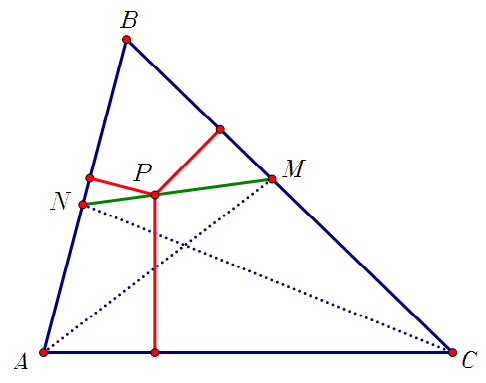The line through the feet of the bisectors

In the previous image and are bisectors and lies on the line segment . Prove that the distance from to line is equal to the sum of the distances from to lines and .
What happen if lies on the line but outside the triangle?
Now draw the circumcircle of triangle and suppose the ray intersects the circumcircle at ( is between and ). Prove that .
No vote yet
1 vote
Easy Math Editor
This discussion board is a place to discuss our Daily Challenges and the math and science related to those challenges. Explanations are more than just a solution — they should explain the steps and thinking strategies that you used to obtain the solution. Comments should further the discussion of math and science.
When posting on Brilliant:
*italics*or_italics_**bold**or__bold__paragraph 1
paragraph 2
[example link](https://brilliant.org)> This is a quote# I indented these lines # 4 spaces, and now they show # up as a code block. print "hello world"\(...\)or\[...\]to ensure proper formatting.2 \times 32^{34}a_{i-1}\frac{2}{3}\sqrt{2}\sum_{i=1}^3\sin \theta\boxed{123}Comments
I proved The first 1... and based on that created a problem. Maybe if u likeJorge,,,, you may share this problem. So here's the problem. In an acute angled triangle ABC we have BC=4,AC=5,AB=6. BM and CN are the internal bisectors of B and C. P is any point on the segment MN. If [△PMC]=1 and [△PNB]=4 , find [△BPC] . ( it wud be nice if u mention a little credit to me.. :P )
Log in to reply
Reply if you find this problem interesting! :)
Log in to reply
I think there are too many conditions in your problem. Triangle ABC is fixed and also the points M and N, thus if you choose P in line segment MN such that [BPN]=2 then [CPM] is determined and is not equal to 4. Another idea is to calculate [MNBC] and then find [BPC] (I think the answer will be different of yours).
Try this problem (using your notation):
If [BPN]=2, what is the correct value of [CMP]?
Then cant we fix P and say that suppose there exists a point P on MN such that ........ ?
However, solution to #1. Let PX⊥BC, PY⊥AC and PZ⊥AB. We drop MM1⊥BC, MZ1⊥AB and NN1⊥BC and NY1⊥AC. Now we have △BM1M≅△BMZ1 (right angle, angle and side equal) and hence MZ1=MM1. Similarly we have, NN1=NY1.
We use similarity in triangles MPY and MNY1.
NY1PY=NMMP and we get PY=NMPM×NY1...(i) Similarly we have PZ=NMNP×MZ1...(ii)
Now, NN1,PX,MM1 are 3 parallel lines . So we have NMPM=M1N1M1X.... (iii) We join N,M1 and let that intersect PX at L.
Using △NLP∼NM1M , we have MM1PL=NMNP and thus PL=NMNP×MM1=NMNP×MZ1. (as MM1=MZ1 ... (iv)
And, similarly using △M1XL∼△M1N1N , we have
LX=N1M1XM1×NN1=NMPM×NY1...(v)
We observe that (iv)+(v) is indeed (i)+(ii) and Hence PY+PZ=PL+LX=PX
Log in to reply
Is it correct Jorge??
Log in to reply
It seems good, but you misplaced the points, for example you said MM1 perpendicular to BC.